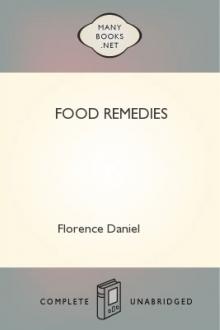The Healthy Life Cook Book, 2d ed. by Florence Daniel (read any book txt) 📕

First put on the chestnuts (without shelling or pricking) in cold water,and boil for an hour. Then remove shells and put the nuts in an enamelledsaucepan with the fat. Fry for 10 minutes. Add the flour gradually,stirring all the time, then add the water. Cook gently for half an hour.Lastly, add the parsley, boil up, and serve.
It is rather nicer if the flour is omitted, the necessary thickness beingobtained by rubbing the soup through a sieve before adding the parsley.Those who do not object to milk may use 1 pint milk and 1 pint water inplace of the 1-1/2 pints water.
5. FRUIT SOUP.
Fruit soups are used extensively abroad, although not much heard of inEngland. But they might be taken at breakfast with advantage by thosevegetarians who have given up the use of tea, coffee and cocoa, and objectto, or dislike, milk. The recipe given here is for apple soup, but pears,plu
Read free book «The Healthy Life Cook Book, 2d ed. by Florence Daniel (read any book txt) 📕» - read online or download for free at americanlibrarybooks.com
- Author: Florence Daniel
- Performer: -
Read book online «The Healthy Life Cook Book, 2d ed. by Florence Daniel (read any book txt) 📕». Author - Florence Daniel
Melt the butter in a small iron saucepan or frying pan and sprinkle into it the flour. Keep stirring gently with a wooden spoon until the flour is a rich dark brown, but not burnt, or the flavour will be spoilt. Then add very gently, stirring well all the time, rather less than half-a-pint of hot water. Stir until the mixture boils, when it should be a smooth brown gravy to which any flavouring may be added. Strained tomato pulp is a nice addition, but a teaspoonful of lemon juice will suffice.
4. BUTTERED RICE AND PEAS.1 cup unpolished rice, 3 cups water, 2 cups fresh-shelled peas, 1 tablespoon finely chopped parsley, 1 teaspoon lemon juice, butter size of walnut.
Put the rice on in the water and bring gradually to the boil. Boil hard for five minutes, stirring once or twice. Draw it to side of stove, where it is comparatively cool, or, if a gas stove is used, put the saucepan on an asbestos mat and turn the gas as low as possible. The water should now gradually steam away, leaving the rice dry and well cooked.
Steam the peas in a separate pan. If young, about 20 minutes should be sufficient; they are spoiled by over-cooking.
Add the cooked peas to the cooked rice, with the butter, parsley, and lemon juice. Stir over the fire until the mixture is thoroughly hot.
Serve with or without tomato sauce and new potatoes.
5. CONVALESCENTS' SOUP.1 small head celery, 1 large onion, 1 carrot, 1 turnip, 3 tablespoons coarsely chopped parsley, P.R. Barley malt meal, Mapleton's or P.R. almond or pine-kernel cream, 3 pints boiling water.
Well wash the vegetables and slice them, and add them with the parsley to the boiling water. (The water should be distilled, if possible, and the cooking done in a large earthenware jar or casserole. See notes re casseroles in Chap. IV.) Simmer gently for 2 hours, or until quite soft. Then strain through a hair sieve. Do not rub the vegetables through the sieve to make a purée, simply strain and press all the juices out. The vegetable juices are all wanted, but not the fibre. To each pint of this vegetable broth allow 1 heaped tablespoon barley malt meal, 1 tablespoon nut cream, and 1/2 lb. tomatoes. Mix the meal to a thin paste with some of the cooled broth (from the pint). Put the rest of the pint in a saucepan or casserole and bring to the boil. Add the meal and boil for 10 minutes. Break up the tomatoes and cook slowly to a pulp (without water). Rub through a sieve. (The skin and pips are not to be forced through.) Add this pulp to the soup. Lastly mix the nut-cream to a thin cream by dripping slowly a little water or cool broth into it, stirring hard with a teaspoon all the time. Add this to the soup, re-heat, but do not boil, serve.
This soup is rather irksome to make, but is intensely nourishing and easy of digestion. The pine-kernel cream is the more digestible of the two creams. Care should be taken not to cook these nut creams. If the soup is for an invalid care should also be taken that, while getting all the valuable vegetable juices, no skin or pips, etc., are included. The vegetable broth may be prepared a day in advance, but it will not keep for three days except in very cold weather. (When it is desired to keep soup it should be brought to the boil with the lid of the stockpot or casserole on, and put away without the lid being removed or the contents stirred.)
6. FINE OATMEAL BISCUITS.2 ozs. flour, 3-1/2 ozs. Robinson's "Patent" Groats, 2 ozs. castor sugar, 2 ozs. butter, 2 eggs.
Cream the butter and sugar, add the eggs, then the flour and groats, which should be mixed together. Roll out thin and cut out with a cutter. Bake in a moderate oven until a light colour.
7. FINE OATMEAL GRUEL.1 heaped tablespoon Robinson's "Patent" Groats, 1 pint milk or water.
Mix the groats with a wineglassful of cold water, gradually added, into a smooth paste, pour this into a stew-pan containing nearly a pint of boiling water or milk, stir the gruel on the fire (while it boils) for ten minutes.
8. MACARONI CHEESE.1/4 lb. macaroni, 1-1/2 ozs. cheese, 1/2 pint milk, 1 teaspoon flour, butter, pepper.
The curled macaroni is the best among the ordinary kinds. Better still, however, is the macaroni made with fine wholemeal flour which is stocked by some food-reform stores. Parmesan cheese is nicest for this dish. Stale cheese spoils it.
Wash the macaroni. Put it into fast-boiling water and keep boiling until very tender. Drain off the water and replace it with the 1/2 pint of milk. Bring to the boil and stir in the flour mixed to a thin paste with cold milk or water. Simmer for 5 minutes. Grate the cheese finely.
Butter a shallow pie-dish. Put the thickened milk and macaroni in alternate layers with the grated cheese. Dust each layer with pepper, if liked. Top with grated cheese. Put some small pieces of butter on top of the grated cheese. Put in a very hot oven until nicely browned.
9. MANHU HEALTH CAKE.1/4 lb. butter, 1/2 lb. castor sugar, 1/2 lb. Manhu flour, 1 oz. rice flour, 6 ozs. crystallised ginger, 4 eggs.
Cream butter and sugar, adding eggs, two at once, not beaten. Beat each time after adding eggs, add rice flour, ginger, and lastly flour. Bake in moderate oven.
10. MANHU HOMINY PUDDING.1-1/2 teacupfuls of boiled Hominy (see below), 1 pint or less of sweet milk, 1/2 teacupful of sugar, 2 eggs (well beaten), 1 teacupful of raisins, spice to taste.
Mix together and bake twenty minutes in a moderately hot oven. Serve hot with cream and sugar or sauce.
11. PARKIN.2 ozs. butter, 2 ozs. moist sugar, 6 ozs. best treacle, 1/2 lb. medium oatmeal, 1/4 lb. flour, 1/2 oz. powdered ginger, grated rind of 1 lemon.
Some people prefer the addition of carraway seeds to lemon rind. If these are used a level teaspoonful will be sufficient for the quantities given above. The old-fashioned black treacle is almost obsolete now, and is replaced commercially by golden syrup, many brands of which are very pale and of little flavour. To make successful Parkin a good brand of pure cane syrup is needed. I always use "Glebe." This is generally only stocked by a few "high-class " grocers or large stores, but it is worth the trouble of getting. Some Food Reform Stores stock molasses, and this was probably used for the original Parkin. It is strongly flavoured and blacker than black treacle, but its taste is not unpleasant. For the sugar, a good brown moist cane sugar, like Barbados, is best. Put the treacle and butter (or nutter) into a jar and put into a warm oven until the butter is dissolved. Then stir in the sugar. Mix together the oatmeal, flour, ginger and seeds or lemon rind. Pour the treacle, etc., into this, and mix to a paste. Roll out lightly on a well-floured board to a 1/4 inch thickness. Bake in a well-greased flat tin for about 50 minutes, in a rather slow oven. To test if done, dip a skewer into boiling water, wipe, and thrust into the Parkin; if it comes out clean the latter is done. Cut into squares, take out of tin, and allow to cool.
12. PROTOSE CUTLETS.1 lb. minced Protose, 1 lb. plain boiled rice, 1 small grated onion, 1/2 teaspoon sage.
Mix the ingredients with a little milk; shape into cutlets, using uncooked macaroni for the bone, and bake in a moderate oven about 45 minutes.
13. PROTOSE SALAD.1 breakfast-cupful Protose cubes, 1/3 breakfast cup minced celery, 1 hard-boiled egg, 3 small radishes, juice of 2 lemons.
Cut Protose into cubes, chop the hard-boiled egg, slice the radishes. Add to the minced celery. Pour over these ingredients the lemon juice and allow the mixture to stand for one hour. Serve upon fresh crisp lettuce.
14. RISOTTO.3/4 lb. rice, 1/2 lb. cheese, 4 large onions.
Slice and fry the onions in a stew-pan in a little fat; when brown, add 1-1/2 pints water and the rice. Let it cook about an hour, and then add the grated cheese.
This dish may be varied with tomatoes when in season.
15. ROYAL NUT ROAST.1/2 lb. pine kernels, 2 medium-sized tomatoes, 1 medium onion, 2 new-laid eggs.
Wash, dry and pick over the pine kernels and put them through the macerating machine. Skin and well mash the tomatoes. Grate finely the onion. Mix all together and beat to a smooth batter. Whisk the eggs to a stiff froth and add to the mixture. Pour into a greased pie-dish. Bake in a moderate oven until a golden-brown colour. It should "rise" like a cake. It may be eaten warm with brown gravy or tomato sauce, or cold with salad.
16. STEWED NUTTOLENE.Slice one half-pound nuttolene into a baking dish, adding water enough to cover nicely. Place it in the oven, and let it bake for an hour. A piece of celery may be added to give flavour, or a little mint. When done, thicken the water with a little flour, and serve.
17. WELSH RAREBIT.Cheese, butter, bread, pepper.
Cut thin slices of cheese and put them with a little butter into a saucepan. When well melted pour over hot well-buttered toast. Dust with pepper. Put into a very hot oven for a few minutes and serve.
18. YEAST BREAD.7 lbs. flour, salt to taste (about 3/4 ounce), 1 ounce yeast, 1-1/2 quarts of warm water.
Put the flour into a pan or large basin, add salt to taste, and mix it well in. Put the yeast with a lump of sugar into a small basin, and pour a little of the warm water on to if. Cold or hot water kills the yeast. Leave this a little while until the yeast bubbles, then smooth out all lumps and pour into a hole made in the middle of the flour. Pour in the rest of the warm water, and begin to stir in the flour. Now begin kneading the dough, and knead until the whole is smooth and damp, and leaves the hand without sticking, which will take about 15 to 20 minutes. Time spent in kneading is not wasted.
Set the pan in a warm place, covered with a clean cloth. Be careful not to put the pan where it can get too hot. The fender is a good place, but to the side of the fire rather than in front. Let it rise at least an hour, but should it not have risen very much—say double the size—let it stand longer, as the bread cannot be light if the dough has not risen sufficiently.
Now have a baking-board well floured, and turn all the dough on to it. Have tins or earthenware pans, or even pie-dishes well greased. Divide the dough, putting enough to half fill the pans or tins. Put these on the fender to rise again for 20 to 30 minutes, then bake in a hot oven, about 350 degrees (a little hotter than for pastry).
Bake (for a loaf about 2 lbs. in a moderate oven) from 30 to 40 minutes. Of course the time depends greatly on the size of the loaves and the heat of the oven.
The above recipe produces the ordinary white loaf. Better bread would, in my opinion, result from the use of a very fine wholemeal flour such as the "Nu-Era," and the omission of salt.
XIV.—UNFIRED FOOD.The true unfired feeder is an ideal, i.e., he exists only in idea, at least so far as my experience goes! To be truly consistent the unfired feeder should live entirely on raw foods—fruit, nuts and salads. But most unfired feeders utilise heat to a slight extent, although they do not actually cook the food. In addition, most of them use various breadstuffs and biscuits which, of course, are cooked food. "Unfired" bread is sold by some health food stores, and is a preparation of wheat which has been treated and softened by a gentle heat.
Cereals should never be eaten with fruit, but may be eaten with salads and cheese. The mid-day meal of the unfired feeder





Comments (0)